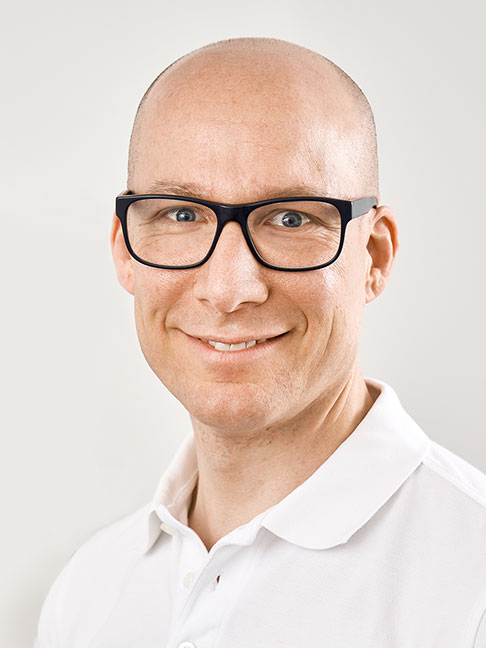Cervical Spine (C-spine) Surgery
- Cervical spine pain: Symptoms and onset
- Causes for cervical spine pain
- When is surgery a good option for cervical spine syndrome?
- Which surgical procedures does Gelenk-Klinik offer?
- Which type of physician performs cervical spine surgery?
- Preparing for cervical spine surgery
- What type of anaesthesia is used for cervical spine surgery?
- Which aids will Ion need following surgery?
- Should I expect pain after cervical spine surgery?
- What will my stay be like at Gelenk-Klinik?
- What do I need to keep in mind after surgery?
- How much is cervical spine surgery?
- How can international patients schedule cervical spine surgery?
Cervical spine pain: Symptoms and onset
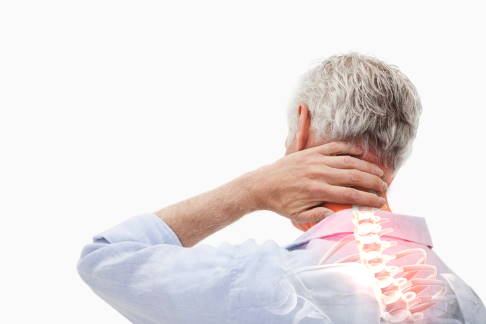 Cervical spine pain. © joint-surgeon
Cervical spine pain. © joint-surgeon
As the uppermost part of the spine, the cervical spine supports the head. It has a total of seven cervical vertebrae (C1 to C7). The first cervical vertebra (atlas) is situated directly below the foramen magnum (large opening), an opening through which the spinal cord passes into the vertebral canal. The second cervical vertebra (axis) is responsible for skull rotation. It has a tooth-like structure (dens axis) which the atlas rests on. The main purpose of the cervical spine is to stabilise and move the head and protect the spinal cord. Cervical spine pain or injuries are therefore serious events which should be examined by a specialist.
Pain in the back, neck or arm can be signs of cervical spine syndrome, or C-spine syndrome for short. A distinction is usually made between acute cervical spine syndromes and chronic cervical spine syndromes. Acute cervical spine syndromes are typically caused by injuries caused by sudden overstraining. This includes e.g., injury to the cervical spine in traffic accidents, the so-called whiplash injury of the cervical spine. However, acute cervical spine syndromes can also arise due to unusual strain from heavy physical activity or by exposure to draughts. Another trigger for pain in the cervical spine is acute spinal disc herniation (disc prolapse), where the inside of the disc emerges from the nucleus and compresses the spinal cord nerves.
Chronic cervical spine syndromes are usually due to degenerative changes of the supporting structures in the cervical spine. This particularly affects the intervertebral joints (facet joints). But even sideways deviations of the spine (scoliosis) can be a factor. The degeneration of the discs with resulting bulging discs (disc protrusion) due to degenerative changes of the fibrous cartilage ring (annulus fibrosus) is also often a cause. This surrounds the disc nucleus.
Neck pain, often radiating into the arms, is a typical symptom of cervical spine syndrome. This can also be accompanied by tension and hardening in the adjacent muscles. Pain can not only radiate into the arms and hands, but also into the head, causing severe headaches, dizziness, impaired vision and tinnitus. Even neurological symptoms such as numbness, an impaired sensation of warmth and cold, tingling or even signs of paralysis may occur.
Depending on pain radiation, doctors speak of “upper", “middle" or “lower" cervical spine syndrome:
- Upper cervical spine syndrome:
Upper cervical spine syndrome often causes pain to radiate into the back of the head, sometimes even pulling over the ears and into the forehead region. In this case, the change in the vertebral joints is also a factor. So-called uncovertebral arthrosis refers to a degenerative change in the joints between vertebrae. - Middle cervical spine syndrome:
With middle cervical spine syndrome, the pain will typically radiate to between the shoulder blades and past the shoulder. In this case, problems with nerve function accompanied by symptoms in the arms may also occur. In addition to pain in the arms, numbness or even paralysis may occur in the arm. - Lower cervical spine syndrome:
Like upper cervical spine syndrome, lower cervical spine syndrome causes problems in the arm. In addition to pain in the arm, it is characterised by pain radiating all the way into the hand, and the respective nerve root in the cervical spine can be determined based on where the pain is located.
Causes for cervical spine pain
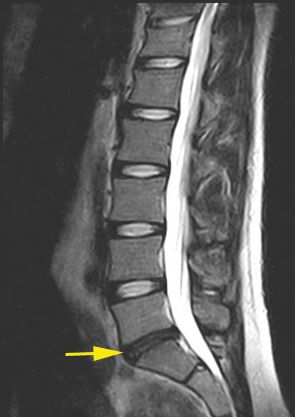 Degenerated disc with lower fluid content. © joint-surgeon
Degenerated disc with lower fluid content. © joint-surgeon
Degenerative (wear-related) changes:
- Disc changes (protrusion or prolapse)
- Ligament problems (ligament dysfunction)
- Vertebral joint disorders
- Osteophytic reactions (bone spurs on the cervical spine)
Congenital developmental disorders:
- Scoliosis or Scheuermann's disease
- Vertebral anomaly (wedge-shaped or block vertebrae)
Inflammatory diseases:
- Rheumatoid arthritis
- Bekhterev's disease (inflammatory arthritis, primarily of the spine)
- Infectious diseases of the cervical spine (so-called spondylitis or spondylodiscitis due to bacteria)
Metabolic disorders:
- Osteoporosis (loss of bone density)
- Rickets (disorder of the bone structure and remodeling)
Tumours:
- Primary tumors (plasmacytoma)
- Metastases
Injuries:
- Fractures
- Whiplash injuries of the cervical spine
When is surgery a good option for cervical spine syndrome?
- Paresis (paralysis)
- Dysesthesia, numbness
- Considerably worsening pain resistant to treatment
With cervical spine syndrome, damage to the nerve root or cervical cord must primarily be ruled out. This means that particularly in recurring cervical spine syndrome, the entire spectrum of clinical, x-ray and neurological diagnostics is used. In addition to a thorough physical examination, this includes electromyographic (EMG) and magnetic resonance imaging (MRI) to diagnose changes in the cervical spine.
If pain, loss of sensation and paralysis greatly reduce the quality of life, cervical spine surgery is a good option. Medical aspects in favour of surgery are neurological deficits (paralysis, numbness and formication) and other symptoms. In many cases, early intervention is best, e.g. to implant a prosthetic disc, reducing pressure on the spinal cord in the cervical spine.
With chronic cervical spine syndrome due to generative changes in the cervical spine, recurring symptoms can be expected. In addition, complete resolution of symptoms can often no longer be achieved. In this case, it is important to carefully deliberate when stabilising surgery of the cervical vertebra and potentially fusion (spondylodesis) or implanting a prosthetic disc to preserve mobility is necessary.
Which surgical procedures does Gelenk-Klinik offer?
There are different surgical procedures depending on the cause of cervical spine pain.
Nucleoplasty
Nucleoplasty is an endoscopic procedure used to treat a not fully herniated disc. If the fibrous ring around the nucleus is bulging outwards and compresses the spinal cord nerves, nucleoplasty can treat this disc protrusion without open surgery. With this procedure, a high-frequency probe is inserted into the affected disc. Using an electric probe inserted under constant x-ray monitoring, the surgeon shrinks the nucleus to such an extent that it no longer presses against the spinal cord nerve. With over 80% satisfied and pain-free patients, this procedure has an excellent success rate.
Disc prosthesis
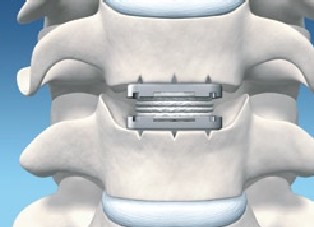 A cervical disc prosthesis can replace the biological disc. © Spinal Kinetics
A cervical disc prosthesis can replace the biological disc. © Spinal Kinetics
Artificial discs have been a reliable and common treatment for degenerated discs for over ten years now. The disc prosthesis offers a particularly promising alternative to the previously commonly used fusion (spondylodesis) of individual vertebrae. It is intended to restore the natural mobility and function of the disc. The disc prosthesis is intended to minimise or even entirely eliminate symptoms associated with disc degeneration and a herniated disc, chronic back pain, and neurological losses. Replacing the natural disc, the prosthesis protects the spine from further degeneration, stabilising it in the long term. Here at Gelenk-Klinik, we replace cervical discs with type M6-C discs. These disc prostheses last a lifetime and do not need to be replaced.
Fusion (spondylodesis)
Progressive wear of the spine often reduces the space between vertebrae. The space between the vertebrae narrows. The spine becomes unstable and the vertebrae shift forward, backward, or to the side. If all conservative treatment options have been exhausted and even minimally-invasive procedures are no longer promising, fusing the painful area of the spine is the last resort. A combination of screws and small connecting rods immobilises the affected area of the spine. With today’s techniques, this can typically be done as a minimally-invasive procedure through small skin incisions. However, this spondylodesis typically does not completely eliminate symptoms but rather improves pain in the cervical spine.
Which type of physician performs cervical spine surgery?
Here at Gelenk-Klinik we believe a close relationship between the physician and their patient is important. This means that you will be in the care of your attending physician from discussing your medical history until after surgery. So, you will have one contact person who will be very familiar with your condition and assigned to you throughout your stay at Gelenk-Klinik. Our specialist for back pain and spine surgery is the experienced neurosurgeon Dr David-Christopher Kubosch.
Preparing surgical spine surgery
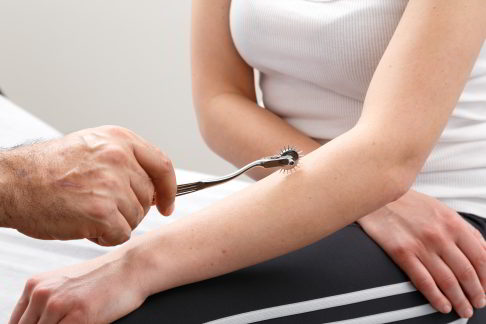 The neurosurgeon tests sensitivity and checks for differences between sides. Different stimuli such as temperature sensation, vibration or sense of touch are used. © joint-surgeon
The neurosurgeon tests sensitivity and checks for differences between sides. Different stimuli such as temperature sensation, vibration or sense of touch are used. © joint-surgeon
First the physician will perform a thorough medical examination. Diagnostic imaging is used to help understand the results. Medical examination means: Discussing the medical history and a physical examination. Diagnostic imaging means: Taking x-rays lying down and standing, so weight-bearing. Furthermore, an MRI (magnetic resonance imaging) is important to determine the condition of the discs and nerves in the spinal column. A bone density measurement may also be performed to determine the stability of the bones and to rule out osteoporotic changes.
After determining the patient’s suitability for surgery, the treating physician will discuss the procedure and possible complications of cervical spine surgery with the patient. In addition, there will be a detailed discussion with the anaesthetist, who will again review the patient’s health condition with respect to anaesthesia. Once approved by the anaesthetist and the surgeon, the surgery can typically be performed the day after the examination.
What type of anaesthesia is used for cervical spine surgery
Cervical spine surgery is performed under general anaesthesia. The anaesthetist will inject a combination of anaesthetics individually tailored to your body. You will feel no pain during the surgery and will not be aware of the procedure. An experienced anaesthetist will be present throughout the procedure, monitoring your vital functions and ensuring you do not wake up during the surgery.
Which aids will I need following surgery?
In the first days following surgery it will be important to rest your cervical spine and move it as little as possible. To ensure this, you will receive cervical support, i.e. a neck brace or cervical spine splint for 2–6 weeks. This will stabilise your cervical spine and prevent any abrupt movements.
Should I expect pain after cervical spine surgery?
Every procedure causes pain. We always strive to keep pain after cervical spine surgery as low as possible. Once the general anaesthesia wears off, you will receive pain medication by IV or in form of tablets. Our goal is for you to experience as little pain as possible.
What will my stay be like at Gelenk-Klinik?
 Private room in the Gelenk-Klinik in Gundelfingen, Germany
Private room in the Gelenk-Klinik in Gundelfingen, Germany
During your inpatient stay at Gelenk-Klinik you will have a single-occupancy room. The room has a bathroom with a shower and WC. All rooms include towels, a bathrobe and slippers. They further include a mini-bar and a safe. All rooms also have a television. You only need to bring your personal medication, comfortable clothes and sleepwear. After surgery, you will receive 24-hour care from experienced nursing staff and experienced physiotherapists. The inpatient stay following CS surgery is typically 4 days. Your family members can stay at a hotel within walking distance. We will gladly take care of the reservation and plan your stay for you.
What do I need to keep in mind after surgery?
After surgery you should rest your spine and avoid any sudden movement. Your cervical spine will be immobilised with a neck brace (cervical collar or brace) for 2 to 3 days. This limits head rotation to 30°. Depending on the physician’s instructions you will receive manual therapy to resolve functional disorders of the musculoskeletal system from our experienced physiotherapists. The sutures do not need to be removed, as we use special absorbable sutures. So, you will already be able to shower 7 days after surgery.
- Inpatient treatment: 4 days
- Optimal local stay: 10–14 days
- Earliest return flight: 7 days after surgery
- Recommended return flight: 14 days after surgery
- Showering permitted: 7 days after surgery
- Recommended time off work: 4 weeks (varies by job)
- Recommended removal of sutures: None (absorbable sutures)
- Time before being able to drive again: 2 weeks
- Outpatient physiotherapy: 2 weeks
How much is cervical spine surgery?
In addition to the cost of surgery you will also need to plan for additional costs for diagnosis, physician’s appointments and aids (e.g., cervical brace). If you plan to have outpatient physiotherapy in Germany after surgery, we will gladly schedule the appointments with the physiotherapists and obtain an estimate of costs.
You will find information about the cost of hotel lodging and any follow-up treatment at the rehabilitation clinic on the websites of the respective providers. We will gladly assist you with planning your rehabilitation stay.
How can international patients schedule cervical spine surgery?
We will first need recent MRI images, and particularly x-rays of the cervical spine to assess the condition of the discs, vertebrae and facet joints. After sending these to us through our website, we will send you patient information including proposed treatment and a binding estimate of costs within 1–2 days.
Gelenk-Klinik offers quick appointments for international patients to correspond with your preferred travel itinerary. We will gladly help you apply for a visa once we have received the down payment specified in the cost estimate. If the visa is denied, we will promptly refund the full down payment.
We try to minimise the time between the preliminary examination and the surgery for our international patients to shorten your stay and avoid additional travel. During your inpatient and outpatient stay our multi-lingual (English, Russian, Spanish, Portuguese) case management team will be there to assist you. We can also provide an interpreter (e.g., Arabic) at any time, at the patient’s expense. We will gladly assist you with organising transportation and lodging and provide tips for recreational activities for your family members.

